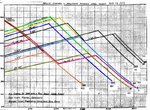This simply is not supported by the experiences over Malta, where both hurricanes and Fulmars fought side by side in a situation heavily dominated by the enemy. Fulmar here was at least as challenged as it would have been had it been used over SE England, and whilst I freely agree it had no chance of affecting the air state, claiming it would be shot out of the sky over SE England because of the superior performance of the 109 is just a fallacy.... Speed is basically irrelevant to survivability. Speed leads to whether you can gain the upper hand, it counts for virtually nothing when you are fighting slow moving bombers. it was because their speed advantage, along with their numbers and the skill of their pilots that the 109s dominated the sky over Malta for so long as they did.
You're contradicting yourself; in one sentence you say speed was not essential, yet you also state the reason the 109s dominated over Malta was because of their speed advantage and their numbers and pilot skill?
These are exactly the advantages the far larger numbers of 109s the Fulmars would have encountered over SE England would have enjoyed. 265 mph (Fulmar Mk I) v 354 mph? That isn't just a "speed advantage" - the 109 could cruise faster than a Fulmar's top speed! Apart from that, the Fulmars in the Mediterranean, or over and around Malta, rarely, if ever encountered Bf 109s, nor can I find references to Fulmars shooting down 109s - but, I'll keep looking.
Not to mention the Fulmar's very slow rate of climb cf Spitfires and Hurricanes. The British fighters were at their most vulnerable when they were climbing for altitude where they could be - and often were - bounced by 109s which were already flying at higher altitudes. Fulmars trying to climb to altitude after a scramble would have been far more vulnerable. The slow ROC also meant that Fulmar units would have needed to be scrambled far earlier than the Spitfire and Hurricane units, or Fighter Command would have been forced to fly standing patrols in the hope that they could intercept Luftwaffe formations.
Unfortunately, had Fulmars been employed in large numbers during the B of B, they would have been shot down in large numbers before they could close with the Luftwaffe bombers.


